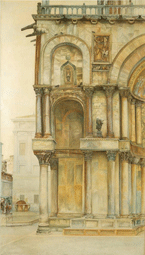North-western Corner of the Basilica of San Marco, Venice
John Wharlton Bunney (1828-1882). Watercolour and bodycolour on paper, 1870.
WorkCook and Wedderburn print a note on this work, which was intended by Ruskin to form part of a future Museum catalogue:'Showing the method of Greek mosaic as applied to Byzantine Architecture. Painted from nature by Mr. John Bunney.
The varieties of colour represented in this painting as existing in the ancient marbles, are slightly, though unintentionally exaggerated by the artist's earnest attention to them; but the emphasis upon them is not more than that which is continually given by conventional and admired treatment to the chiaroscuro of interesting effects, or the markings of anatomical form -- colour being in both cases almost totally sacrificed. Throughout the series of works I have commissioned for the Museum illustrative either of landscape, or natural history, it will be found that I have steadily insisted on primary fidelity to colour, both because it is the quality least recognized at present by the schools developed in smoky capitals; and because it is the most cheerful and refreshing influence which can be employed to fix the spectator's attention on a work of art. [...] The value of this careful study of St. Mark's from nature will be more strongly felt on comparing it with the coloured plates of the great work on St. Mark's, which, though extremely careful and valuable, are gloomy in consequence of the blackness of the lithograph beneath them. The illustrations of the mosaic pavement are, however, free from this defect, and extremely lovely -- failing only in rendering the perpetual irregularity and freedom of hand in the execution, which nothing short of a photograph, or facsimile of small portions by hand, could rightly represent [...] Mr. Bunney's drawing of St. Mark's was executed for the Museum about the year 1872, and presented by him to the Museum.' (Works, 30, p. 203). ArtistJohn Bunney first encountered Ruskin in the 1850s, as a student at the Working Men's College in London. Collection of the Guild of St George, Museums Sheffield
A brief biography is supplied by a fellow student called J. P. Emslie:'The son of a merchant captain, Bunney had, when very young, made several voyages round the world. At an early age he took to drawing, but the death of his father compelled him to abandon art and apply himself to less attractive work. When I first joined the Drawing Class, he was engaged at a bookseller's, and was a hard-working student whose work was greatly admired by Ruskin. For a time his work was hard, but in 1858 he made a number of drawings in Derbyshire which so charmed Mr. Ruskin that he gave Bunney commissions to make drawings in Italy and in Switzerland' ( 'Recollections of Ruskin', The Working Men's College Journal, June 1908, x, p. 345).
Ruskin on BunneyRuskin valued Bunney's capacity for capturing detail, and had been especially impressed by him on a visit to Verona in 1869. From there, Ruskin reported that 'I am getting on well with all my own work, and much pleased with some that Mr. Bunney is doing for me, so that really I expect to carry off a great deal of Verona' (Works, 19, p. l). Having stationed Bunney in Venice for the purpose of 'catching' architectural detail, Ruskin suggested that his drawings 'will become of more value to their purchasers every year, as the buildings from which they are made are destroyed' (Works, 22, p. 476). |



















